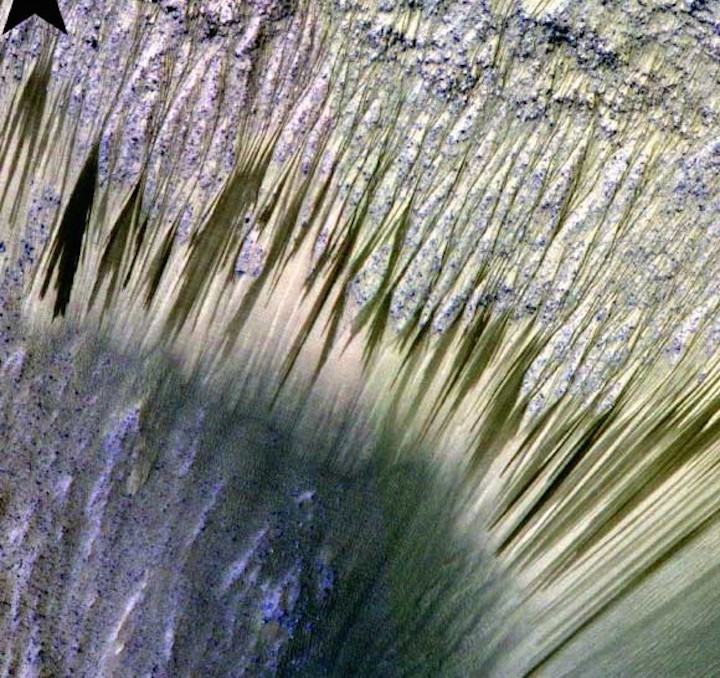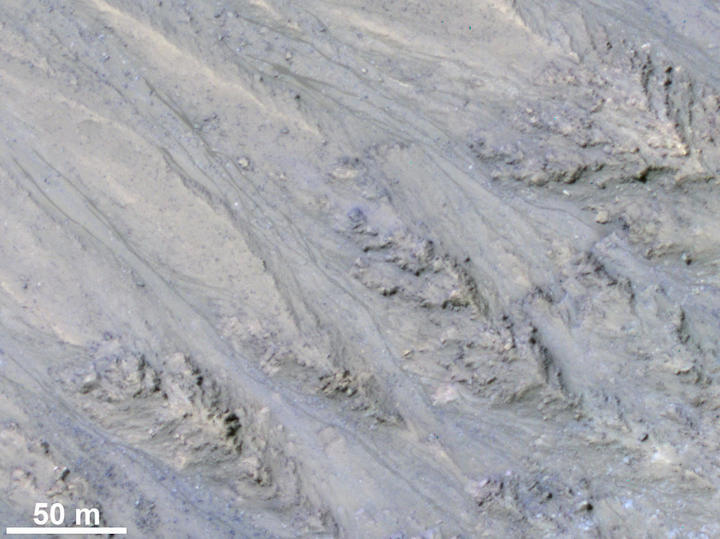21.11.2017

Scientists have long been intrigued by what seem to be wet streaks that appear on the slopes of Martian craters in warm weather, and disappear in winter. Now a research team reports that the best explanation is that they’re not wet streaks at all, but streaks of dust and sand.
The findings, published today in Nature Geoscience, are likely to disappoint those who hoped that the features known as recurring slope lineae, or RSLs, point to sources of liquid water beneath the Red Planet’s surface.
“This new understanding of RSL supports other evidence that shows that Mars today is very dry,” study lead author Colin Dundas of the U.S. Geological Survey’s Astrogeology Science Center said in a news release.
Some astrobiologists had hoped that the areas around the RSLs just might harbor subsurface life. That’s why NASA has said the thousands of potential RSL sites, including a smattering of prospects near the Curiosity rover, should be off-limits for the time being due to concerns about contamination.
The report in Nature Geoscience is based on an analysis of 151 streaky features at 10 sites. Nearly all of the streaks appear on slopes that are steeper than 27 degrees, which would be consistent with the behavior of tumbling sand. If the streaks were caused by water seeping from the subsurface, they should be seen on slopes that are less steep, the researchers say.
What’s more, all of the streaks stop at a place matching the dynamic “angle of repose” that applies to sand dunes on Mars and on Earth.
“It can’t be a coincidence,” said the University of Arizona’s Alfred McEwen, the principal investigator for the High Resolution Imaging Science Experiment on NASA’s Mars Reconnaissance Orbiter.
So why do the streaks gradually appear starting in the spring, and fade away in the winter? Researchers suggest that hydrated salts in Martian soil might pull traces of water vapor out of Mars’ thin atmosphere when the weather warms, triggering flows of sand. The darkening and lightening of the streaks could be linked to changes in hydration over the course of the Red Planet’s seasons.
Why the streaks appear on some slopes and not others is a puzzle yet to be solved.
“RSL probably form by some mechanism that is unique to the environment of Mars, so they represent an opportunity to learn about how Mars behaves, which is important for future surface exploration,” McEwen said.
Rich Zurek, project scientist for the Mars Reconnaissance Orbiter at NASA’s Jet Propulsion Laboratory, said a full understanding of how RSLs bloom and fade would probably require on-site investigation. But that investigation will still have to be conducted carefully, he said.
“While the new report suggests that RSL are not wet enough to favor microbial life, it is likely that on-site investigation of these sites will still require special procedures to guard against introducing microbes from Earth, at least until they are definitively characterized,” Zurek said.
In addition to Dundas and McEwen, the authors of “Granular Flows at Recurring Slope Lineae on Mars Indicate a Limited Role for Liquid Water” include Matthew Chojnacki, Moses Milazzo, Shane Byrne, Jim McElwaine and Anna Urso.
Quelle: GeekWire
+++
Previous Evidence of Water on Mars Now Identified as Grainflows
Dark features previously proposed as evidence for significant liquid water flowing on Mars have now been identified as granular flows, where sand and dust move rather than liquid water, according to a new article published in Nature Geoscience by the U.S. Geological Survey.
These new findings indicate that present-day Mars may not have a significant volume of liquid water. The water-restricted conditions that exist on Mars would make it difficult for Earth-like life to exist near the surface of the planet.
Scientists from the USGS, the University of Arizona, Durham University (England) and the Planetary Science Institute analyzed narrow, down-slope trending surface features on Mars that are darker than their surroundings, called Recurring Slope Lineae, or RSL. These RSL features grow incrementally, fade when inactive and recur annually during the warmest time of year on Mars. RSL are mostly found on steep rocky slopes in dark regions of Mars, such as the southern mid-latitudes, Valles Marineris near the equator, and in Acidalia Planitia on the northern plains. The appearance and growth of these features resemble seeping liquid water, but how they form remains unclear, and this research demonstrated that the RSL flows seen by HiRISE are likely moving granular material like sand and dust.
“We’ve thought of RSL as possible liquid water flows, but the slopes are more like what we expect for dry sand,” said USGS scientist and lead author Colin Dundas. “This new understanding of RSL supports other evidence that shows that Mars today is very dry.”
The terminal end of the RSL slopes, said Dundas, are identical to the slopes of sand dunes where movement is caused by dry granular flows. Water almost certainly is not responsible for this behavior, which would require the volume of liquid to correspond to the length of slope available, producing more liquid on longer slopes. Instead, the 151 RSL examined by the study authors all end on similar slopes despite very different lengths. Additionally, said the scientists, water is unlikely to be produced only near the tops of slopes at these angles and if it were, it should be able to flow onto lower slopes.
This new research finds that these RSL features are flows of granular material and thus, align with the long-standing hypothesis that the surface of Mars lacks flowing water. Small amounts of water could still be involved in their initiation in some fashion, as hydrated minerals have been detected at some RSL locations. The authors conclude that liquid on present-day Mars may be limited to traces of dissolved moisture from the atmosphere and thin films of water.
This study was done in cooperation with the NASA Mars Reconnaissance Orbiter project.

This HiRISE image cutout shows Recurring Slope Lineae in Tivat crater on Mars in enhanced color. The narrow, dark flows descend downhill (towards the upper left). Analysis shows that the flows all end at approximately the same slope, which is similar to the angle of repose for sand.Credit: NASA/JPL/University of Arizona/USGS. Public domain.
Quelle: USGS
